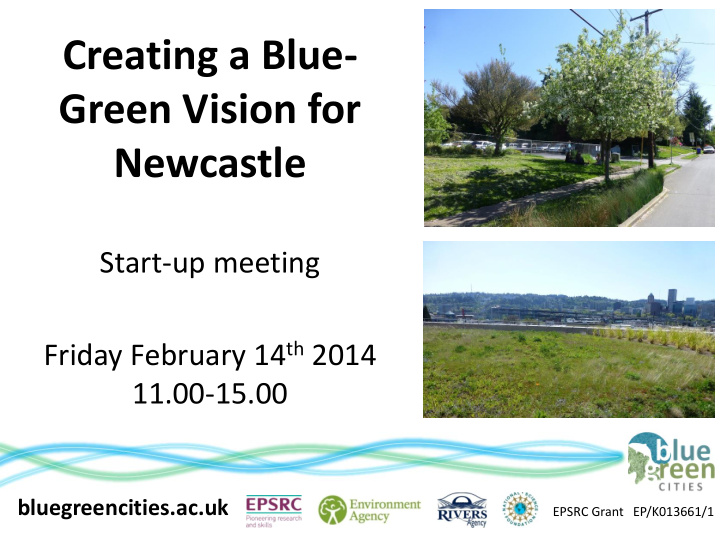



Creating a Blue- Green Vision for Newcastle Start-up meeting Friday February 14 th 2014 11.00-15.00 bluegreencities.ac.uk EPSRC Grant EP/K013661/1
Workshop agenda 11.00 Introduction to the Blue-Green Cities Research Project, Emily Lawson 11.15 Mapping and managing flood risk in Newcastle with CityCAT, Chris Kilsby, Vassilis Glenis, Vedrana Kutija 11.30 Comparative UK/Australia study of retrofit SuDS in the CBD for improved flood mitigation, Jessica Lamond 11.45 Q&A session 1 12.00 Local perspectives on Blue-Green Cities, Kit England (Newcastle City Council) 12.15 Partnership approach to sustainable drainage area planning, Martin Kennedy (NWL) 12.30 Q&A session 2 12.45 Lunch and networking
Workshop agenda 13.30 Briefing on the Learning and Action Alliance (LAA) and discussion of membership options, Jessica Lamond 13.50 Presentation on a stakeholder map for Newcastle, Glyn Everett (UWE) 14.00 Workshop exercise; validating the stakeholder map and discussing how different stakeholder groups perceive, utilise and value Blue-Green infrastructure 15.00 Closing remarks and end of meeting Invitation to an evening reception (Monday 17 th March, Caledonian Hotel, Newcastle) with BGC team and US collaborators
Delivering and Evaluating Multiple Flood Risk Benefits in Blue-Green Cities
J4M8, Edinburgh Hebden Bridge Case Study City: Newcastle Wortley Beck, Leeds The Dings, Bristol
International Collaborations Portland, Oregon Ningbo, China Blue-Green Cities are working with: Blue-Green Cities are working with Ningbo academics James Griffiths, David Higgitt, Faith Chan and Odette Paramor
Hydrologic and environmental attributes in Grey and Blue- Green Cities
Develop and rigorously evaluate strategies for managing flood risk that deliver multiple benefits as part of urban planning and renewal
Model Existing Model Flood Risk Citizens’ Management Behaviours Options for Evaluate Stakeholder and Hard/Soft Multiple Flood Community Measures Risk Benefits Communications Demonstration Case Study
WP1. Communications AIMS Facilitate co-production of knowledge. Increase internal communication between academics. Enhance external communications with academics, practitioners and stakeholder communities. Strategies • Project website (www.bluegreencities.ac.uk), intranet and forum • Social media • Wikipedia entry • Regular meetings, workshops and co-location working • External; Learning and Action Alliance (WP5)
WP1. Uncertainty Fidelity Verification Sensitivity Uncertainty Validity Quantification Relevance
WP2a. Flood Inundation – 4 tasks Representing Blue-Green infrastructure in a model of urban inundation Modelling morphology and transport of sediment and debris through Blue-Green infrastructure Incorporating agents into an urban inundation model (Agent-Based Modelling, ABM) Developing probability maps of urban inundation to manage down risks and support resilient responses
WP2a. Flood Inundation – CityCAT Water depth map of Ouseburn catchment (area = 120km 2 , cell size = 2m, cells = 30million). Storm event = 60 minutes, 100-year return period
WP2b. Sediment, morphology, habitats AIM: assess sediment transport and debris dynamics within Blue-Green urban drainage networks and develop improved approaches to accounting for the risks and benefits associated with Blue-Green infrastructure. PIT technology
WP2c. Behavioural responses and ABM AIM; To provide evidence-based rules about the behaviour of individuals and institutions to feed into the ABM ABM – what would be the impact of installing water butts in all domestic properties? Social Practice Theory approach ; investigating how practices, behaviours and preferences may change over time
WP3. FRM components and interfaces • Develop tools and methodologies to represent urban FRM and Blue-Green networks within a single urban environment • Examining interdependencies with wider urban infrastructure • Development of a “flood footprint” accounting tool Source Adelard Document 2009.
Three point approach for urban FRM Blue Condition 2. Adaptation in the wider urban area. New spaces for water conveyance and urban storage 1. Design standards apply. Levels of service are met 3. Urban green space used on a day to day basis by community Green Condition Fratini et al.,(2012) Three Points Approach (3PA) for urban flood risk management .
WP4. Evaluation and synthesis of benefits Aim; Develop procedures for the robust evaluation of the multiple functionalities of Blue-Green infrastructure components within FRM strategies • Evaluate the relative significance of benefits in context specific locations • Establish preference ratings • Review current design procedures and make recommendations to the design guidance to enhance the most significant non-flood benefits
Identified WP5. Demo flood risk Study (pluvial/ fluvial)? Change flood Data risk availability management strategies? Demo Case Study City? Buy-in from all Is Blue-Green local infrastructure stakeholders viable?
Potential Demonstration Cities Newcastle Glasgow Derby Leeds
Delivering and Evaluating Multiple Flood Risk Benefits in Blue-Green Cities Acknowledgement The research reported in this presentation is being conducted as part of the Blue-Green Cities Research Consortium with support from the: • Engineering and Physical Sciences Research Council • Northern Ireland Rivers Agency • Environment Agency • National Science Foundation bluegreencities.ac.uk EPSRC Grant EP/K013661/1
Recommend
More recommend